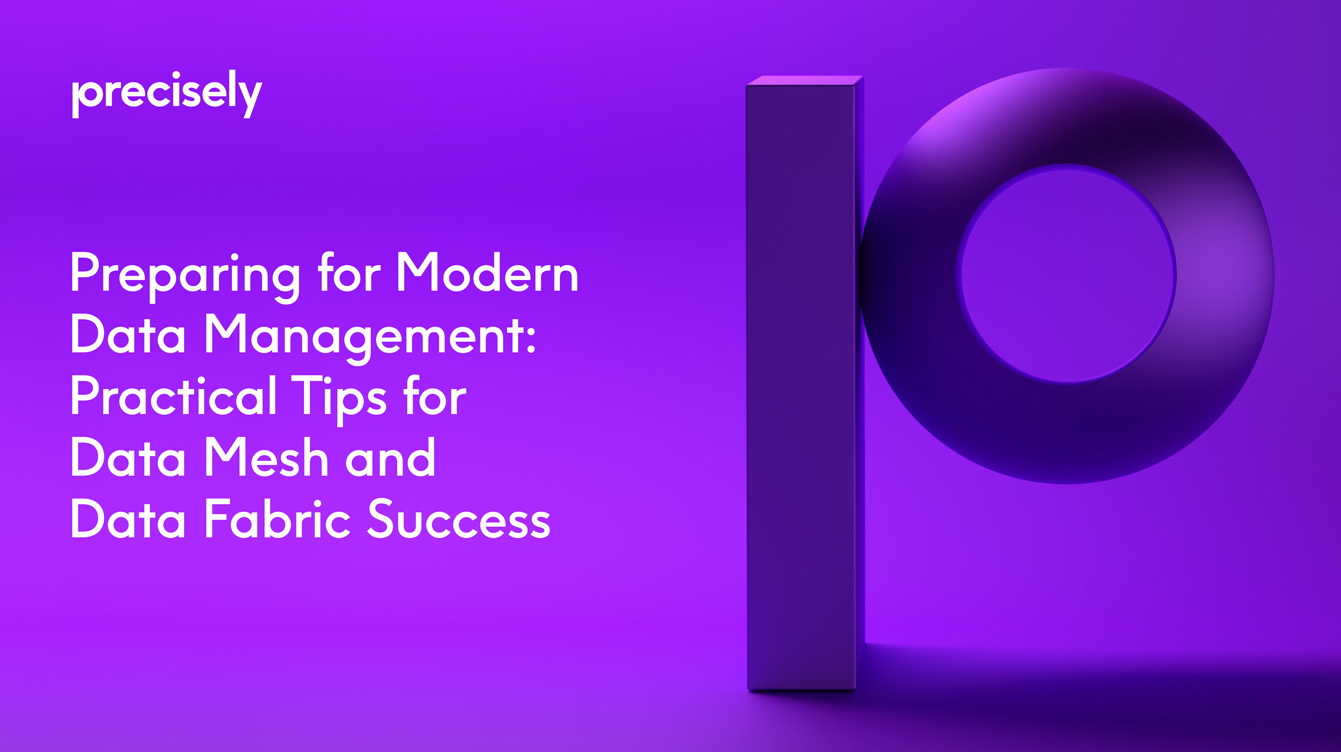eBook
Preparing for Modern Data Management: Practical Tips for Data Mesh and Data Fabric Success
Introduction
The modern data age presents new realities and possibilities for organizations across the board. It also means that your ability to make timely and trusted data-driven decisions is a meaningful competitive differentiator.
But as data volumes, varieties, and platforms continue to expand, so do the complexities of managing your critical data.
Modern data management architectures are reshaping how businesses handle data by enhancing how data is integrated and accessed. This streamlined access is crucial for delivering the real-time data that’s essential for strengthening top objectives with greater data integrity, including:
- informed decision-making
- accurate analytics
- ability to leverage artificial intelligence
Additionally, automated data management processes and stringent security and governance measures reduce errors and protect sensitive information, boosting operational efficiency and regulatory compliance.
And the agility offered by modern data management architectures allows you to quickly adapt to changing data demands, promoting a nimble and responsive approach to market changes. This flexibility accelerates decision-making processes through real-time insights and empowers business users with self-service capabilities, enabling them to discover and leverage data independently.
This shift towards a data-driven culture ensures a significant edge for organizations adopting a modern data management approach to harness their data effectively.

Modern Data Management Options: Data Mesh & Data Fabric
Two modern data management architectures have emerged to accelerate the delivery of trusted data to users: data mesh and data fabric.
Both architectures rely on a combination of data management solutions that work together to improve efficiency and accelerate data-driven decisions by making data easily accessible and actionable for your team.
Each architecture also has additional unique benefits, challenges, and use cases. Let’s explore data mesh and data fabric in more detail.
Data Mesh
What is Data Mesh?
Data mesh is a modern decentralized (or federated) architectural approach that allows your organization to make more timely and trusted data-driven decisions by empowering domain owners to create, organize, and maintain trusted data products for data users.
A data product is typically defined as a reusable set of data, metadata, semantics, and templates curated and maintained for a specific business purpose, although this may differ between organizations.
Data mesh requirements include:
- self-service access to all critical data by domain experts
- federated or decentralized data governance
- a user-friendly interface to discover, understand, and access approved data products within and across domains

Data Mesh Benefits
Data mesh can help address the challenges of more centralized data architectures by supporting agility, scalability, and innovation while improving data quality, governance, and alignment with business objectives at the domain level. Benefits include:
- faster data product delivery: domain owners can respond quickly to data requests and create high-value data products for unique use cases. A faster response makes your business more agile and innovative.
- accelerated discovery: data users can quickly determine if a data product exists that fits their purpose, and domain experts can be more efficient when creating or expanding data products. The result? No more duplicate efforts.
- enhanced data policy monitoring: data mesh mitigates privacy, security, and policy risks while maintaining domain autonomy.
![]()
Data Mesh Challenges
But data mesh also comes with challenges:
Governance maturity
Data mesh relies on decentralized data ownership and governance, and there may not be clear guidelines or processes for data owners, leading to issues that impact compliance, privacy, and data quality.
Domain accountability
Implementing a data mesh involves organizational change in which domain teams own and manage their own data products. That accountability requires buy-in, and SMEs (subject matter experts) may not be willing – or have the bandwidth – to be held accountable for sharing, maintaining, and governing data products.
Skills gap
Data mesh requires skills to design shared services and integrations to support self-service access. If your teams don’t have the skills, the architecture can be extremely consultant-heavy.
Data silos
When domain owners focus on their individual domains, multiple redundant data products may be created across your organization – which is inefficient.
Cultural change management
Decentralization of data access and data product ownership is a cultural change your teams must embrace. Strong leadership is required to ensure a successful data mesh project.
Data Mesh Use Cases
Your organization may choose a data mesh architecture to empower domain teams with autonomy over their data, facilitating faster innovation and quicker responses to specific business needs. Here are a few examples of the many use cases across industries:
Regulatory Compliance and Reporting
Organizations may choose data mesh to adapt quickly to new compliance or regulatory requirements.
The challenges
Financial institutions face the challenge of managing complex compliance data across varied business units with distinct regulatory demands. Centralized data systems often lag in adapting to regulatory changes, heightening non-compliance risks.
The data mesh benefits
Data mesh allows each business unit – like retail banking or insurance – to manage its own compliance data, customizing governance to meet specific regulatory requirements.
This decentralization accelerates responsiveness to regulatory updates and enhances compliance. A federated governance framework ensures that domains operate autonomously while still adhering to universal compliance standards, which minimizes penalties and boosts regulatory trust.

Clinical Research and Development
A data mesh architecture may be ideal for organizations that need to empower research teams to react quickly to new information impacting research and development.
The challenges
Healthcare clinical research faces hurdles with lack of centralized data management, leading to delays, data inconsistencies, and confidentiality issues that impact research effectiveness.
The data mesh benefits
Data mesh enables individual research teams to improve access and analysis speed with the ability to independently manage specific data domains like patient records or clinical trials. This decentralization allows for strong, accurate data quality and compliance controls that facilitate rapid advancements in drug development and personalized medicine.
By granting teams autonomy over their data, data mesh enhances innovation and significantly boosts healthcare outcomes.
Energy Consumption and Distribution
Utility companies that require local or regional teams to monitor and analyze their consumption and distribution closely can benefit from a data mesh architecture.
The challenges
Utility companies face challenges in managing real-time data across diverse geographic locations and systems, leading to inefficiencies in energy distribution and customer service.
The data mesh benefits
With a data mesh, regional utility hubs can autonomously manage and analyze energy usage data. This streamlines localized decision-making that enhances grid efficiency and customer response times.
This approach empowers local teams to tailor energy solutions based on regional demand, significantly improving operational agility and the ability to address and resolve service issues while optimizing energy distribution quickly.
Preparing for a Data Mesh: Best Practices
If a data mesh architecture seems right for you, here are some best practices that can accelerate your success:
Empower domain teams
A data mesh empowers domain teams – domain subject matter experts, owners, and stewards – to create, organize, and maintain trusted data products so data users can make more timely data-driven decisions. This is an organizational change where subject matter experts who understand the data are tasked with delivering data products.
Provide self-service access to domain data
Data mesh must provide trusted data owners with self-service access to all critical domain data so they can quickly respond to user requests.
At the domain level, data products can range from a simple data file with specific attributes and quality requirements to highly complex data products created for specific business purposes. Domain experts may also use data quality, geo addressing, spatial analytics, or data enrichment capabilities appropriate for specific data requests.
Make data products discoverable on demand
Making data available as data products is sometimes referred to as data sharing through a “data marketplace.” Think of it as an Amazon-like shopping experience where users can review details and access or collaborate on the data asset or product they choose.
Whether or not a formal data marketplace exists, data consumers need a centralized, searchable repository to easily discover, understand, and access data products with the appropriate permissions.
Without an organized, business-friendly sharing of data products, your teams risk wasting valuable time duplicating efforts to build products that may already exist. Also, users lack a single source to determine if a data product already exists and whether it’s truly fit for their purpose.

Prioritize data governance at the domain level
Federated or decentralized data governance is key to data mesh success. When you empower data teams with self-service access to critical data, the responsibility – and risk – of closely monitoring data policies and standards shifts to the domain level.
Data governance is essential to ensure privacy and security, and it must be balanced with the autonomy needed to empower data users to quickly understand if data products are fit for their purpose. This makes data governance maturity foundational to a successful data mesh strategy.

Data Fabric
What is Data Fabric?
A data fabric is a modern data management architecture for creating a unified, consistent way to manage, access, and share your data across distributed environments, whether on-premises or in the cloud.
Using data integration techniques, metadata management practices, and other specialized tools, data management recommendations and data products emerge dynamically from the fabric through automation, activation, and AI/ML analysis of metadata.
A data fabric architecture requires a combination of data management solutions that work together – it’s not one single tool or technology. Data fabric design includes:
- technology components, including data integration techniques for continuous data capture, augmented data catalogs for automated metadata management, and knowledge graphs for efficient data organization and retrieval
- metadata activation for enhanced data operations
- recommendation engines for relevant data management insights
- centralized governance to ensure compliance and data literacy across your organization
Data Fabric Benefits
A data fabric helps you boost agility and innovation by providing a unified view of data across environments. It also strengthens data quality, governance, and compliance in distributed data environments.
Benefits include:
- advanced analytics and faster decisions: with easy access to high-quality, real-time data – wherever it’s stored – you can leverage advanced analytics and accelerate decision-making based on the usage of your data.
- trusted AI (artificial intelligence) outcomes and recommendations: power AI/ML-driven models and processes with accessible, reliable, and effectively managed data.
- automated data management recommendations and insights: optimize data management and processes with AI/ML-driven insights into your data usage.
- improved compliance and security: data fabric is supported by centralized data governance – ensuring your data is managed in compliance with guidelines and regulations, wherever it’s stored and however it’s used.
Data Fabric Challenges
But data fabric also comes with challenges:
Development
There’s no single data fabric solution; it’s an architecture built of separate components that work together. To design and implement a data fabric,
you need a mature data engineering team to combine and integrate tools from different vendors.
Metadata maturity
A lack of metadata or active metadata management practices in the early stages can hinder the success of your data fabric architecture.
Skill and resource gaps
Your organization may not have the talent or resources to implement a complex architecture, especially as some of the technology needed is still evolving.
Cultural shifts
Adopting a data fabric strategy challenges more traditional technology practices of collecting data in silos using traditional ETL or modeling techniques. You need strong leadership for a successful data fabric project.
Data Fabric Use Cases
A data fabric is useful for large, diverse organizations that need a single access point to all relevant data in their landscapes. You may also choose this architecture if you need to make data-driven decisions based on a comprehensive, trusted view of data, or if you need to establish centralized rules for who can see and use specific data.
Here are a few examples of top data fabric use cases across industries:
Claims Processing and Management
Insurers may choose a data fabric for a more holistic approach to addressing top challenges.
The challenges
Insurance companies often grapple with slow and error-prone claims processing due to disparate data sources, including policyholder information, claims details, and third-party data. Fragmentation can lead to delays in claims resolutions, inaccurate claims assessments, and poor customer satisfaction.
The data fabric benefits
Data fabric enables automation of the claims handling process, which reduces manual entry errors and accelerates claim resolution times. Benefits include enhanced accuracy and speed of claims evaluations, improved fraud detection, and increased member satisfaction powered by faster, more transparent, and more accurate claims services.
Supply Chain Optimization
Manufacturers that require more complete visibility across business silos may opt for a data fabric to improve their supply chain.
The challenges
Manufacturers often deal with complex, multi-tiered supply chains where a lack of visibility into real-time data can lead to inefficiencies and delays. Optimizing operational processes and supply chain management to reduce costs and increase overall efficiencies is also a strong use case for a data fabric architecture.
The data fabric benefits
Improving resource allocation and productivity across many different business functions empowers manufacturers to streamline operations that impact customers, employees, and business partners. Data fabric enables real-time visibility into supply chain data from various sources, enabling predictive analytics for demand forecasting and inventory management. This results in optimized operations, reduced costs, and improved delivery times.
![]()

Personalized Customer Experiences
Retailers may find that data fabric is an ideal option if they need greater visibility into their customers across a complex infrastructure.
The challenge
Retailers face challenges in creating personalized shopping experiences due to fragmented customer data across multiple channels (online, in-store, mobile, etc.).
They also want to better understand their customers’ needs and experiences so they can respond to market changes. This can extend to market research that analyzes customer trends, consumer behavior, and competitor activity that may influence innovation strategies and inform product development.
The data fabric benefits
Data fabric enables a consolidated view of customer interactions and preferences across all channels, enabling advanced analytics and personalized marketing. This leads to improved customer satisfaction, increased loyalty, and higher sales.
Preparing for a Data Fabric: Best Practices
If a data fabric architecture seems right for you, here are some best practices that can accelerate your success:
Integrate critical data
Without access to all critical and relevant data, you’ll have gaps in your data fabric recommendations – delaying the business insights needed to innovate, mitigate risk, and improve operational efficiencies.
Manage metadata
A mature, AI-driven approach to harvesting, profiling, and tagging metadata is essential to data fabric success. Activated metadata is the key element that reveals the size and shape of the data, its usage patterns, and data recommendations.
Centralize data governance
Establish visibility and accountability across the data fabric with centralized data governance to ensure compliance with security, privacy, and other data usage policies. Additionally, improve data literacy to empower data users with a greater understanding of data meaning, quality, lineage, and impact.
Enable self-service data access
Foster a data-centric culture. Enable your business and IT team members to effectively find and leverage any data assets or products that emerge from the data fabric with a user-friendly interface that provides self-service discovery, understanding, and access.


Lay the Foundation for Data-Driven Innovation and Growth
As you navigate the complex landscape of data mesh and data fabric, it’s crucial to understand that both strategies require time and gradual evolution. However, you don’t need to wait until every component is in place to begin your journey.
A practical starting point is to enhance your metadata management and data governance processes.
If you already have mature metadata and governance frameworks, consider using data fabric as a robust foundation for managing your data and building data products. If your organization lacks metadata maturity but has governance systems in place, focus on capturing and using metadata effectively.
On the other hand, if your metadata systems are advanced but governance is lacking, adopt an adaptive governance model to ensure that your data management practices align with organizational needs.
In the future, the best strategy may involve a blend of both where data fabric serves as the technical foundation for data management, while data mesh serves as the operational model for delivering data assets or data products.
Whichever path you take, maturing your data management processes now will help prepare you for the modern data challenges ahead. By laying this groundwork today, your organization will unlock the full potential of modern data architectures, driving innovation and competitive advantage in an increasingly data-driven world.